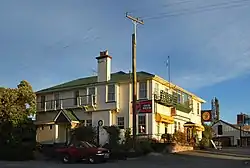Waikari
Waikari is a small town in the Canterbury region of New Zealand's South Island.
Waikari | |
|---|---|
town | |
 The Star and Garter Hotel in Waikari | |
| Coordinates: 42°58′S 172°41′E | |
| Country | New Zealand |
| Region | Canterbury |
| Territorial authority | Hurunui District |
| Ward | West Ward |
| Electorates | |
| Government | |
| • Territorial Authority | Hurunui District Council |
| • Regional council | Environment Canterbury |
| • Mayor of Hurunui | Marie Black |
| • Kaikoura MP | Stuart Smith |
| • Te Tai Tonga MP | Tākuta Ferris |
| Area | |
| • Total | 0.79 km2 (0.31 sq mi) |
| Population (June 2023)[2] | |
| • Total | 270 |
| • Density | 340/km2 (890/sq mi) |
| Time zone | UTC+12 (New Zealand Standard Time) |
| • Summer (DST) | UTC+13 (New Zealand Daylight Time) |
| Postcode | 7420 |
Its Anglican parish church is the Church of Ascension, 79 Princes Street, Waikari, where William Orange was vicar in the 1920s.[3]
The New Zealand Ministry for Culture and Heritage gives a translation of "dig for water" for Waikari.[4]
Waikari is located on State Highway 7 near the Weka Pass and was served by the Waiau Branch railway from 6 April 1882 until its closure on 15 January 1978. The section of the railway through the Weka Pass has been retained by the Weka Pass Railway and preserved trains operate between Waipara and Waikari.
A town water supply was first put to ratepayers in 1956 and the water supply and sewage works were completed in 1966. Fortnightly rubbish collection was in place in Waikari by 1973. In 1984, Waikari (and Hawarden) became the last towns in North Canterbury to be switched to an automatic telephone exchange.[5]
The town is also located near the site of Māori cave art and rock drawings in the Weka Pass Reserve.
Demographics
Waikari is defined by Statistics New Zealand as a rural settlement and covers 0.79 km2 (0.31 sq mi).[1] It had an estimated population of 270 as of June 2023,[2] with a population density of 342 people per km2. Waikari is part of the larger Upper Hurunui statistical area.[6]
| Year | Pop. | ±% p.a. |
|---|---|---|
| 2006 | 252 | — |
| 2013 | 264 | +0.67% |
| 2018 | 264 | +0.00% |
| Source: [7] | ||

Waikari had a population of 264 at the 2018 New Zealand census, unchanged since the 2013 census, and an increase of 12 people (4.8%) since the 2006 census. There were 120 households, comprising 141 males and 126 females, giving a sex ratio of 1.12 males per female, with 36 people (13.6%) aged under 15 years, 27 (10.2%) aged 15 to 29, 123 (46.6%) aged 30 to 64, and 78 (29.5%) aged 65 or older.
Ethnicities were 92.0% European/Pākehā, 11.4% Māori, 4.5% Pasifika, and 2.3% other ethnicities. People may identify with more than one ethnicity.
Although some people chose not to answer the census's question about religious affiliation, 52.3% had no religion, 37.5% were Christian and 2.3% had other religions.
Of those at least 15 years old, 15 (6.6%) people had a bachelor's or higher degree, and 75 (32.9%) people had no formal qualifications. 12 people (5.3%) earned over $70,000 compared to 17.2% nationally. The employment status of those at least 15 was that 84 (36.8%) people were employed full-time, 36 (15.8%) were part-time, and 9 (3.9%) were unemployed.[7]
Education
Waikari School is a co-educational state primary school for Year 1 to 8 students,[8] with a roll of 26 as of April 2023.[9]
Notable people
- Derek Quigley, politician
References
- "ArcGIS Web Application". statsnz.maps.arcgis.com. Retrieved 25 August 2021.
- "Subnational population estimates (RC, SA2), by age and sex, at 30 June 1996-2023 (2023 boundaries)". Statistics New Zealand. Retrieved 25 October 2023. (regional councils); "Subnational population estimates (TA, SA2), by age and sex, at 30 June 1996-2023 (2023 boundaries)". Statistics New Zealand. Retrieved 25 October 2023. (territorial authorities); "Subnational population estimates (urban rural), by age and sex, at 30 June 1996-2023 (2023 boundaries)". Statistics New Zealand. Retrieved 25 October 2023. (urban areas)
- Clark, Jeremy J. "William Alfred Orange". Dictionary of New Zealand Biography. Ministry for Culture and Heritage. Retrieved 4 February 2012.
- "1000 Māori place names". New Zealand Ministry for Culture and Heritage. 6 August 2019.
- Lovell-Smith, Maragaret (2000). Hurunui Heritage The development of a district 1950-2000. New Zealand: Hurunui District Council. pp. 111–130.
- 2018 Census place summary: Upper Hurunui
- "Statistical area 1 dataset for 2018 Census". Statistics New Zealand. March 2020. 7023867 and 7023868.
- "Waikari School Ministry of Education School Profile". educationcounts.govt.nz. Ministry of Education.
- "Waikari School Education Review Office Report". ero.govt.nz. Education Review Office.